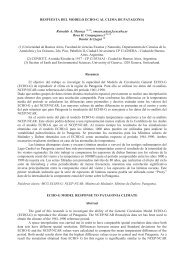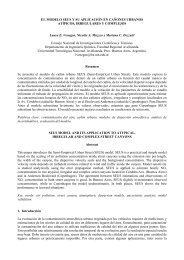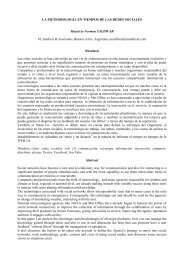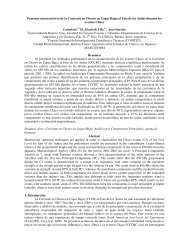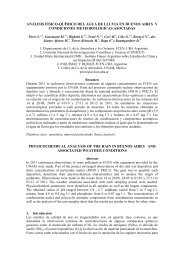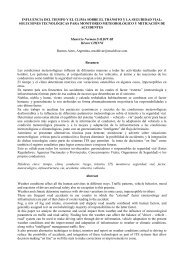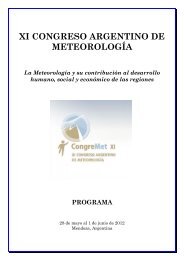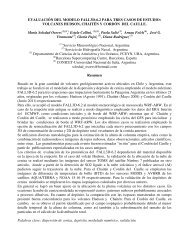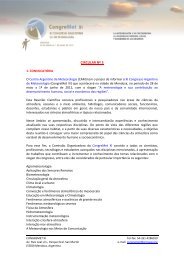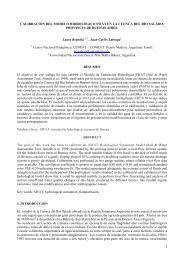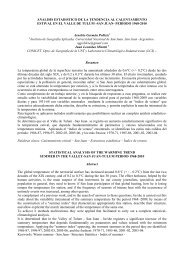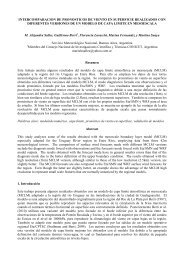XVIII Seminario Nacional de Hidráulica e HidrologÃa
XVIII Seminario Nacional de Hidráulica e HidrologÃa
XVIII Seminario Nacional de Hidráulica e HidrologÃa
You also want an ePaper? Increase the reach of your titles
YUMPU automatically turns print PDFs into web optimized ePapers that Google loves.
IMPLEMENTACIÓN DEL ESQUEMA ISBA EN LA CUENCA DEL RÍO LA VIEJA (CRLV)<br />
Sánchez Rodríguez Inés Cˡ. & Rodríguez Sandoval Erasmo A ²<br />
Universidad <strong>Nacional</strong> - Bogotá, Grupo <strong>de</strong> Investigación en Ingeniería <strong>de</strong> Recursos Hídricos (GIREH).<br />
Tel: 3165000 ext. 13406, 13472, 13478 FAX: 3165563 - Bogotá, Cundinamarca<br />
ˡ < incsanchezro@unal.edu.co>, ²< earodriguezs@unal.edu.co><br />
Resumen<br />
Dado el creciente interés por explorar las interacciones bidireccionales entre el clima y la vegetación, <strong>de</strong>s<strong>de</strong> la década <strong>de</strong><br />
los 80´s se ha impulsado la investigación <strong>de</strong> los acoples entre los mo<strong>de</strong>los <strong>de</strong> la superficie <strong>de</strong>l suelo y los mo<strong>de</strong>los <strong>de</strong><br />
circulación general; no obstante, la condición <strong>de</strong> frontera en la superficie <strong>de</strong> la tierra para los mo<strong>de</strong>los <strong>de</strong> circulación<br />
general, es un mecanismo generalizado <strong>de</strong> corrección, particularmente difícil <strong>de</strong> mo<strong>de</strong>lar. En general, según el IPCC la<br />
mayoría <strong>de</strong> los mo<strong>de</strong>los <strong>de</strong>l ar4 (Fourth Assessment Report) en la escala continental representan los esquemas <strong>de</strong><br />
superficie <strong>de</strong>l suelo (escorrentía) más realísticamente cuando se tiene una a<strong>de</strong>cuada parametrización <strong>de</strong> la hidrología, que<br />
cuando se utiliza un esquema estándar <strong>de</strong> hidrología en las simulaciones <strong>de</strong> largo plazo <strong>de</strong>l clima.<br />
Por ello, entre los avances recientes para la reproducción <strong>de</strong> los procesos <strong>de</strong> la superficie <strong>de</strong>l suelo se encuentran los<br />
esquemas SVATS´s (Surface-Vegetation-Atmosphere Transfer Schemes, por sus siglas en inglés), que son mo<strong>de</strong>los que,<br />
entre otras, incluyen la resistencia estomatal <strong>de</strong> las plantas. El esquema francés ISBA (Soil-Biosphere-Atmosphere<br />
Interaction) pertenece a los mo<strong>de</strong>los SVAT´s. Su física se fundamenta en la parametrización <strong>de</strong> Noilhan & Planton<br />
(1989) y <strong>de</strong>s<strong>de</strong> la primera versión <strong>de</strong>l esquema se ha popularizado su aplicación en distintos tipos <strong>de</strong> estudios.<br />
No obstante, la implementación <strong>de</strong> este esquema a nivel tropical y en particular para el caso colombiano no se ha dado y,<br />
consi<strong>de</strong>rando sus importantes ventajas sobre otros esquemas, así como su satisfactoria aplicación en otros climas y<br />
latitu<strong>de</strong>s, en este artículo se presentan el marco metodológico para su implementación y para el análisis <strong>de</strong> los caudales<br />
en la cuenca hidrográfica <strong>de</strong>l rio La Vieja (Quindío, Risaralda y Valle <strong>de</strong>l Cauca), basados en una primera aproximación<br />
para una caja <strong>de</strong> rejilla. El objetivo último <strong>de</strong> la investigación reportada es evaluar la vali<strong>de</strong>z y calidad en el <strong>de</strong>sempeño<br />
<strong>de</strong>l esquema en una cuenca cafetera tropical, a fin <strong>de</strong> consi<strong>de</strong>rar este esquema para usos operacionales <strong>de</strong> predicción <strong>de</strong>l<br />
tiempo y en proyecciones <strong>de</strong>l impacto <strong>de</strong>l cambio climático en esta y otras cuencas hidrográficas colombianas.<br />
Palabras clave: ISBA, SVAT, río La Vieja, parametrización física <strong>de</strong>l suelo para mo<strong>de</strong>los atmosféricos, simulación <strong>de</strong><br />
caudales.<br />
Bibliografía<br />
[1] Noilhan, J., Planton, S. 1989, A Simple Parametrization of Land Surface Processes for Meteorological Mo<strong>de</strong>ls,<br />
Monthly Weather Review, 536-549<br />
IMPLEMENTATION OF THE SCHEME ISBA ON THE LA VIEJA RIVER BASIN (CRLV)<br />
Sánchez Rodríguez Inés Cˡ. & Rodríguez Sandoval Erasmo A ²<br />
National University - Bogotá, Research Group on Water Resources Engineering (GIREH). Tel: 3165000 ext.<br />
13406, 13472, 13478 FAX: 3165563 - Bogotá, Cundinamarca ˡ , ²<br />
<br />
Abstract<br />
Given the growing interest in exploring the two-way interactions between climate and vegetation since the early 80's has<br />
led the investigation of the coupling between the mo<strong>de</strong>ls of the surface soil and general circulation mo<strong>de</strong>ls, however,<br />
boundary condition on the surface of the land for general circulation mo<strong>de</strong>ls, is a generalized correction mechanism,<br />
particularly difficult to mo<strong>de</strong>l. In general, as most of the IPCC AR4 mo<strong>de</strong>ls (Fourth Assessment Report) on the<br />
continental scale schemes represent the soil surface (runoff) more realistically when you have an a<strong>de</strong>quate<br />
parameterization of hydrology, that when using a standard hydrology schema in the long-term simulations of climate.<br />
Therefore, among the recent progress in the reproduction processes of the soil surface are SVATS's schemes (Surface-<br />
Vegetation-Atmosphere Transfer Schemes for short in English), which are mo<strong>de</strong>ls which, among others, inclu<strong>de</strong> stomatal<br />
resistance of plants. The French scheme ISBA (Soil-Biosphere-Atmosphere Interaction) belongs to the SVAT mo<strong>de</strong>l's.<br />
Its physics is based on Noilhan & Planton parameterization (1989) and since the first version of the scheme has<br />
popularized its application to different types of studies.
However, the implementation of this scheme at tropical and particularly for the Colombian case has not been given and,<br />
consi<strong>de</strong>ring its significant advantages over other schemes and their successful application in other climates and latitu<strong>de</strong>s,<br />
this article presents the framework methodology for implementation and analysis of flows in the watershed of the river<br />
La Vieja (Quindio, Risaralda and Valle <strong>de</strong>l Cauca), based on a first approach to a grid box. The ultimate goal of the<br />
research reported is to assess the validity and quality of performance of the scheme in a basin tropical coffee, to consi<strong>de</strong>r<br />
this scheme for operational use of weather forecasting and projecting the impact of climate change on this and other<br />
basins Colombian basins.<br />
Keywords: ISBA, SVAT, La Vieja, soil physics parameterization for atmospheric mo<strong>de</strong>ls, simulation of flows.<br />
Bibliography<br />
[1] Noilhan, J., Planton, S. 1989, A Simple Parametrization of Land Surface Processes for Meteorological Mo<strong>de</strong>ls,<br />
Monthly Weather Review, 536-549



